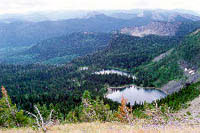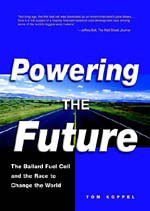The “roadless” road show swept the nation last week as U.S. Forest Service officials collected public comment on President Clinton’s initiative to prohibit road building in national forests where no roads now exist.

What’s missing from this picture?
Photo: U.S. Forest Service.
The policy would affect 43 million acres across the country, including about 5.8 million acres in Montana. The agency is hosting 300 public hearings.
Residents of Missoula, Mont., got a special sideshow. About 2,000 opponents from across western Montana rolled into town on a convoy of logging trucks and buses. Rally attendees included loggers, mill workers, and off-road-vehicle riders. The timber workers are afraid they’ll lose jobs because of the ban. ORV enthusiasts want more roads to ride.
I can sympathize with the loggers and mill workers, but I don’t understand the logic of the motorheads. If you build a road into a wild area, it loses its mystique and becomes just like any other roaded forest. If motorheads aren’t happy with the 380,000 miles of forest roads that already exist, they never will be.

Sign of the times.
Photo: U.S. PIRG.
Loggers have more legitimate concerns. Since 1988, 14 mills in western Montana have closed, putting 1,388 people out of work. Since those layoffs occurred when the Forest Service drastically cut timber harvesting, industry spokespeople blame the federal government. At the rally in Missoula, opponents stuffed written comments into a mock coffin stenciled with the words: R.I.P. Clinton-Gore Roadless Initiative.
Industry spokespeople pointed out that four national forests in western Montana and northern Idaho would lose already-planned timber sales to the road-building ban. But they didn’t mention that the Forest Service would still allow them to cut 75 million board feet of timber in roadless areas by 2005 — without building new roads.
Here are some other facts that industry mouthpieces don’t mention:
- For much of the 1970s and 1980s, timber corporations overcut their private lands, causing erosion and potential flood problems that harm fisheries and defile water quality, according to Forest Service officials. In response, the agency canceled timber sales on adjoining public properties.
- While Montana’s wood products output increased from 1979 to 1986, employment in the wood products industries declined by 2,400 jobs, according to the Department of Commerce.
- Even if federal timber harvests were to increase by 55 percent in the next 50 years, industry employment still would drop by about 27 percent because of mechanization. That’s according to a 1990 General Accounting Office report.
But why believe reports generated by the enemy? What’s the word from the horse’s mouth? Mark Suwyn is chair and CEO of Louisiana Pacific, which employs 244 workers at a mill near Missoula. Suwyn recently warned there might be more layoffs and mill closures. The reason? The stranglehold on public timber? No way. The real nemesis is Federal Reserve Chair Alan Greenspan who set higher interest rates that have slowed the construction market. “Every mill could be affected,” Suwyn told journalists.
Since 1996, Louisiana Pacific has sold or shut down two plywood plants, 35 lumber mills, and four particle board operations. “It’s all about modernization and which mills are best suited,” Suwyn said.

How many more roads do we need?
Photo: USFWS.
It’s understandable that rural Montanans want to save their well-paying jobs. Many of their fellow residents already know the stress of holding down two or three jobs to make ends meet. Montana tops the nation in that category. Many stick out hard economic times to enjoy the mountains, creeks, and lakes that provide a daily spiritual uplift and unlimited recreational opportunities. They also like trees that loggers covet.
Technology and the economy will continue to nibble away at mill jobs no matter how many trees the federal government cuts. But loggers, who deliver the raw product to the factories, have a chance to increase their work opportunities.
Rather than berating public officials for limiting timber harvests, they should lobby the Forest Service to hire them to restore forest health. According to the General Accounting Office, lush undergrowth has created catastrophic fire danger on 39 million acres in the interior West. Thinning the undergrowth not only could curtail the fire danger, but also allow the remaining trees to grow healthier.
Across western Montana and northern Idaho, about 500,000 acres of land that was clear-cut 20 to 30 years ago desperately need thinning. In these areas, loggers with chainsaws would leave the best tree within a 10- to 12-foot diameter and cut every other tree that reaches above their kneecaps. It’s hot, dirty work and not as romantic as toppling tall timber with heavy equipment, but it’s a steady paycheck.
And there would be another benefit to loggers — the wholehearted support of the public.



